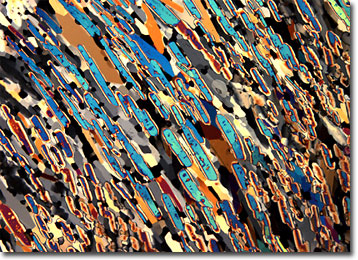Polarized Light Microscopy Digital Image Gallery
Beta-Carotene
Carotenes are fat-soluble, pigmented molecules synthesized by plants that display vitamin A activity. The most important carotene for humans is beta-carotene, which can be found in abundance in yellow and orange vegetables, such as carrots, squash, and sweet potatoes, as well as in various animal products, including liver and egg yolks.

In 1831, beta-carotene was first isolated from the roots of carrots, but it was not until the Nobel prize-winning research of Paul Karrer in the early 1930s that the structure of the substance was determined. The earliest use of synthesized beta-carotene was as a food colorant, but during the 1980s the vitamin precursorís growing reputation as an antioxidant and a possible cancer-fighter resulted in its frequent inclusion in vitamin supplements. Since that time, however, conflicting findings about the benefits of taking synthesized beta-carotene have surfaced. In fact, in one notable study, smokers who were administered regular doses of the synthetic carotene displayed an increased chance of suffering from lung cancer.
Humans and many other animals absorb beta-carotene from food sources through the walls of the small intestine, where it is converted enzymatically to vitamin A, or retinol. Retinol, initially identified in 1920, was the first recognized vitamin, resulting in its being dubbed with the moniker vitamin A under an alphabetical nomenclature system. The important polyene biochemical is believed to promote good vision, dental health, and bone growth, as well as healthy skin, hair, and mucous membranes. The amount of vitamin A believed to be required by the human body on a daily basis, however, is relatively small (1.0 milligrams), and can be provided by the intake of approximately 6.0 milligrams of beta-carotene.
